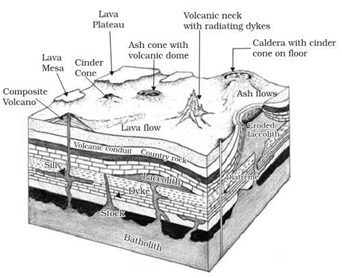- Filter By :
- Geography
- History
- Indian Heritage & Culture
- Indian Society
-
Q. What do you understand by intrusive forms? Briefly describe various intrusive forms. (250 words)
21 Oct, 2019 GS Paper 1 GeographyApproach:
- Explain how volcanic landforms are classified.
- Briefly explain all intrusive landforms with examples.
Introduction
- Volcanic landforms are divided into extrusive and intrusive landforms based on weather magma cools within the crust or above the crust.
- Intrusive landforms are formed when magma cools within the crust and the rocks are known as Plutonic rocks or intrusive igneous rocks.
Body
The intrusive activity of volcanoes gives rise to various forms.

Batholiths
- These are huge mass of igneous rocks, usually of granite, formed due to cooling down and solidification of hot magma inside the earth.
- They appear on the surface only after the denudation processes remove the overlying materials and may be exposed on the surface after erosion.
- Example: Wicklow mountains of Ireland; the uplands of Brittany, France.
Laccoliths
- These are large dome-shaped intrusive bodies connected by a pipe-like conduit from below.
- These are basically intrusive counterparts of an exposed domelike batholith.
- Example: The laccoliths of Henry mountains in Utah, USA.
Lopolith
- As and when the lava moves upwards, a portion of the same may tend to move in a horizontal direction wherever it finds a weak plane.
- In case it develops into a saucer shape, concave to the sky body, it is called Lopolith.
- Example: The Bushveld lopolith of Transvaal, South Africa.
Phacolith
- A wavy mass of intrusive rocks, at times, is found at the base of synclines or at the top of the anticline in the folded igneous country.
- Such wavy materials have a definite conduit to source beneath in the form of magma chambers (subsequently developed as batholiths). These are called the Phacoliths.
- Example: Corndon hill in Shropshire, England.
Sills
- These are solidified horizontal lava layers inside the earth.
- The near horizontal bodies of intrusive igneous rocks are called sill or sheet, depending on the thickness of the material.
- The thinner ones are called sheets while the thick horizontal deposits are called sills.
- Example: Great whin sill of North East England
Dykes
- When the lava makes its way through cracks and fissures developed in the land, it solidifies almost perpendicular to the ground.
- It gets cooled in the same position to develop a wall-like structure. Such structures are called dykes.
- These are the most commonly found intrusive forms in the western Maharashtra area. These are considered the feeders for the eruptions that led to the development of the Deccan traps. Cleveland Dyke of Yorkshire, England.
Conclusion
Volcanic activities have a profound influence on the earth’s landforms. Solid, liquid or gaseous materials may find their way to the surface from some deep-seated reservoir beneath.
To get PDF version, Please click on "Print PDF" button.
Print PDF




